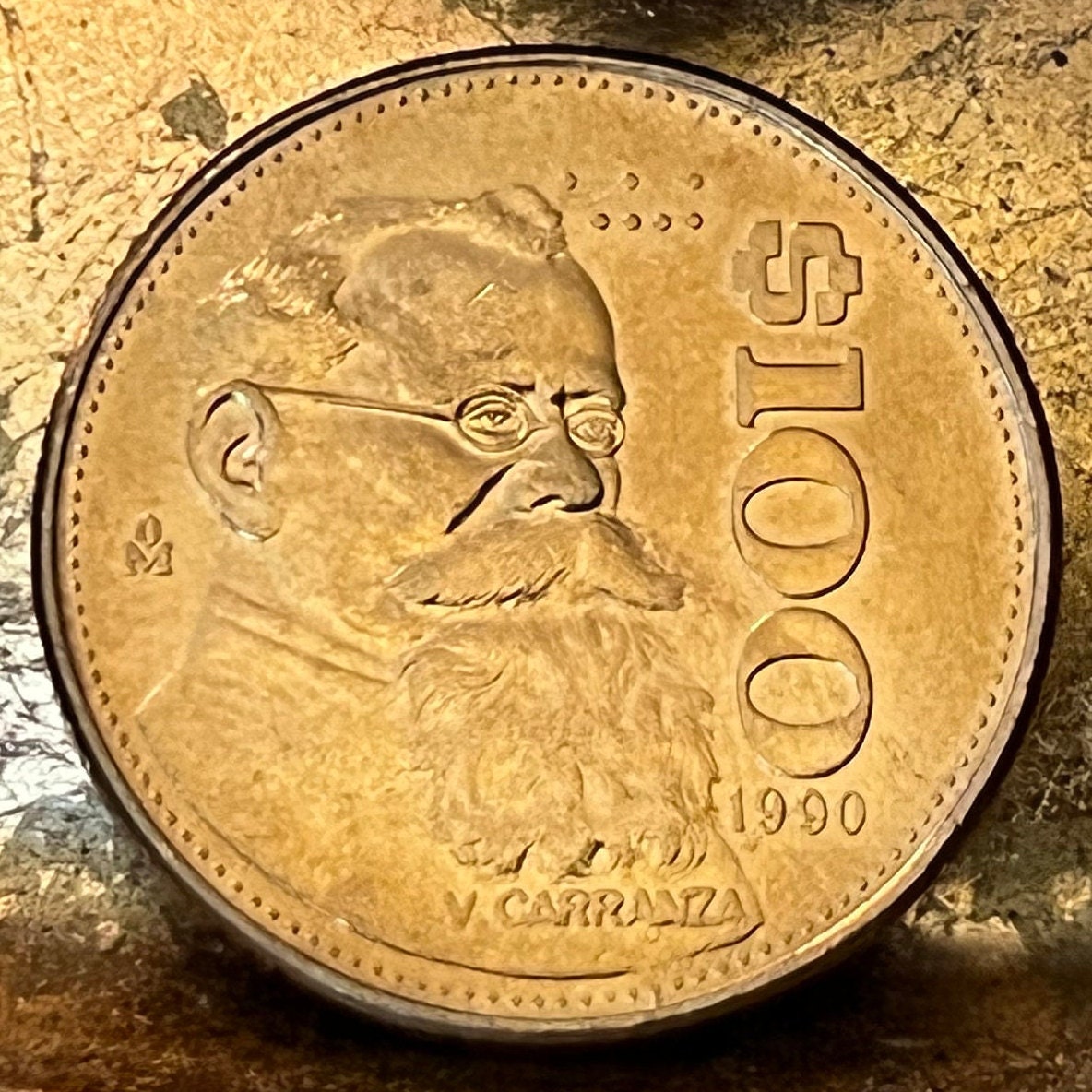elemintalshop
President Venustiano Carranza & Eagle with Snake 100 Pesos Mexico Authentic Coin Money for Jewelry and (First Chief) (Mexican Revolution)
President Venustiano Carranza & Eagle with Snake 100 Pesos Mexico Authentic Coin Money for Jewelry and (First Chief) (Mexican Revolution)
Couldn't load pickup availability
President Venustiano Carranza & Eagle with Snake 100 Pesos Mexico Authentic Coin Money for Jewelry and Craft Making (Mexican Revolution)
Reverse: Portrait of Venustiano Carranza Garza to the right and 7 points above (100 in Braille)
Lettering: ⠂⠴⠴
$100
V.CARRANZA
Translation: 100
100 Pesos
Obverse: "Estados Unidos Mexicanos" in a semicircle over the Mexican coat of arms: a Mexican golden eagle standing on a prickly pear cactus devouring a rattlesnake. At the base of the cactus, there is a holm oak (Encino) branch on one side and a laurel branch on the other.
Lettering: ESTADOS UNIDOS MEXICANOS
Translation: United Mexican States
Edge: Paired Reeding (6 milled parts interrupted by short smooth parts)
Features
Issuer Mexico
Period United Mexican States (1905-date)
Type Standard circulation coin
Years 1984-1992
Value 100 Pesos (100 MXP)
Currency Peso (1863-1992)
Composition Aluminium-bronze
Weight 11.97 g
Diameter 26.5 mm
Thickness 2.8 mm
Shape Round
Technique Milled
Orientation Coin alignment ↑↓
Demonetized 15 November 1995
Number N# 961
References KM# 493, Schön# 86
Wikipedia:
José Venustiano Carranza de la Garza; 29 December 1859 – 21 May 1920) was a Mexican wealthy land owner and politician who was Governor of Coahuila when the constitutionally-elected president Francisco I. Madero was overthrown in a February 1913 right-wing military coup. Known as the Primer Jefe or "First Chief" of the Constitutionalist faction in the Mexican Revolution, Carranza was a shrewd civilian politician. He supported Madero's challenge to the Díaz regime in the 1910 elections, but became a critic of Madero once Díaz was overthrown in May 1911. Madero did appoint him the governor of Coahuila. When Madero was murdered during the February 1913 counter-revolutionary coup, Carranza drew up the Plan of Guadalupe, a purely political plan to oust Madero's usurper, General Victoriano Huerta. As a sitting governor when Madero was overthrown, Carranza held legitimate power and he became the leader of the northern coalition opposed to Huerta. The Constitutionalist faction was victorious and Huerta ousted in July 1914. Carranza did not assume the title of provisional president of Mexico, as called for in his Plan of Guadalupe, since it would have prevented his running for constitutional president once elections were held. His government in this period was in a preconstitutional, extralegal state, to which both his best generals, Álvaro Obregón and Pancho Villa objected. The factions of the coalition against Huerta fell apart and a bloody civil war of the winners ensued, with Obregón remaining loyal to Carranza and Villa, now allied with peasant leader Emiliano Zapata, breaking with him. The Constitutionalist Army under Obregón defeated Villa in the north, and Zapata and the peasant army of Morelos returned to guerrilla warfare. Carranza's position was secure enough politically and militarily to take power in Mexico City, although Zapata and Pancho Villa remained threats. Carranza consolidated enough power in the capital that he called a constitutional convention in 1916 to revise the 1857 liberal constitution. The Constitutionalist faction had fought to defend it and return Mexico to constitutional rule. With the promulgation of a new revolutionary Mexican Constitution of 1917, he was elected president, serving from 1917 to 1920.
The constitution that the revolutionaries drafted and ratified in 1917 now empowered the Mexican state to embark on significant land reform and recognized labor's rights, and curtail the power of the Catholic Church, but Carranza did not implement major reforms once he was duly elected. Once firmly in power in Mexico, Carranza sought to eliminate his political rivals, having Zapata assassinated in 1919. Carranza won recognition from the United States, but nonetheless took strongly nationalist positions.
In the 1920 election, in which he could not succeed himself, Carranza attempted to impose a virtually unknown, civilian politician, Ignacio Bonillas, as president of Mexico. Sonoran revolutionary generals Álvaro Obregón, Plutarco Elías Calles, and Adolfo de la Huerta, who held real power, rose up against Carranza under the Plan of Agua Prieta. Carranza fled Mexico City, along with thousands of his supporters and with gold of the Mexican treasury, aiming to set up his government in Veracruz. Instead he died in an attack by rebels. Although Carranza played a major role in the Revolution, his contributions were not initially acknowledged in Mexico's historical memory, since he was overthrown by rivals. But later as a historical narrative that recognizes the various competing factions as members of the "revolutionary family," Carranza's place in Mexican history has been assured.
********
Wikipedia:
The coat of arms of Mexico (Spanish: Escudo Nacional de México, literally "national shield of Mexico") depicts a Mexican (golden) eagle perched on a prickly pear cactus devouring a rattlesnake. The design is rooted in the legend that the Aztec people would know where to build their city once they saw an eagle eating a snake on top of a lake. The image has been an important symbol of Mexican politics and culture for centuries. To the people of Tenochtitlan, this symbol had strong religious connotations, and to the Europeans, it came to symbolize the triumph of good over evil (with the snake sometimes representative of the serpent in the Garden of Eden).
The Law on the National Arms, Flag, and Anthem regulates the design and use of the arms. They feature in the centre of the flag of Mexico, are engraved on the obverse of Mexican peso coins, and are the basis of the Seal of the United Mexican States, the seal used on any official documents issued by the federal, state or municipal governmental authorities. The seal differs from the arms by the addition of the words Estados Unidos Mexicanos ("United Mexican States", the full official name of the country) in a semicircle around the upper half.
Share



















